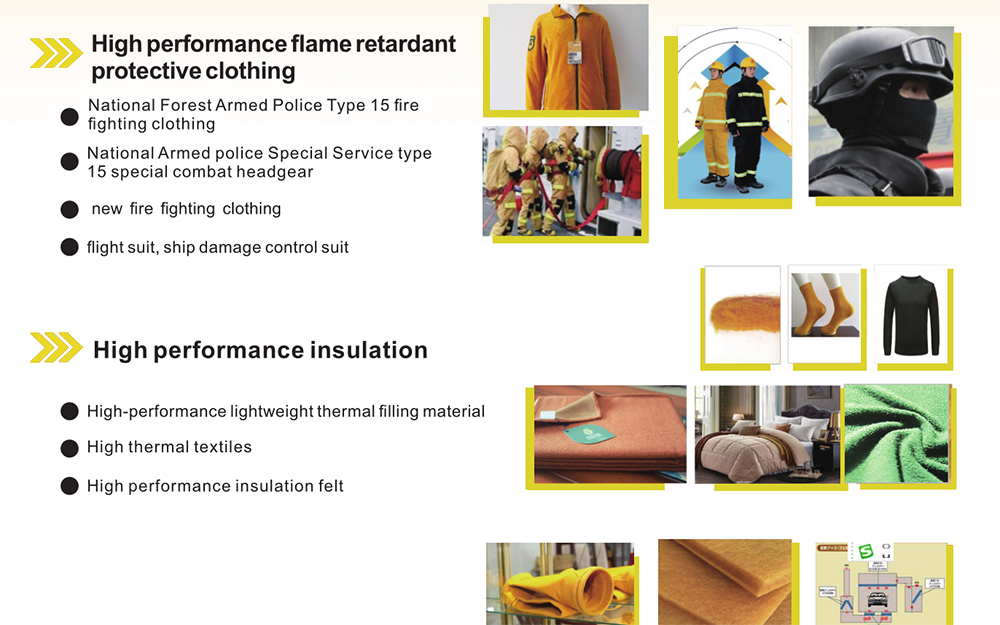Polyimide (PI) is a high-temperature engineering polymer originally developed by DuPont. PI exhibits an excellent combination of thermal stability (>500°C), mechanical toughness and chemical resistance. They have excellent dielectric properties and inherently low coefficient of thermal expansion. They are formed from diamines and dianhydrides.
Polyimide (Polyimide, abbreviated as PI or P84 ) refers to a type of polymer containing an imide ring (-CO-NR-CO) in the main chain. It is one of the organic polymer materials with the best comprehensive properties, has the advantages of wide applicable temperature, chemical corrosion resistance, high strength, etc., and its high temperature resistance can reach over 400°C.The long -term use temperature range is -200~300°C, some parts have no obvious melting point, and have high insulation performance. The dielectric constant is 4.0 at 103 Hz, and the dielectric loss is only 0.004~0.007. It belongs to F to H class insulation.
Polyimide fiber spinning methods are divided into wet spinning and dry spinning. Depending on whether the spinning slurry is polyimide or polyamic acid, there are one-step spinning and two-step spinning. The first step is to spin a concentrated solution of polyamic acid through wet or dry spinning to obtain polyamic acid fiber. The second step is to spin the first step. Polyimide fiber is obtained by chemical cyclization or thermal cyclization of polyamic acid fiber, so it is called a two-step method. Two-step spinning of polyimide fiber is a method that has been commonly used since the development of polyimide fiber. The fiber stretching process can be carried out in the first step, or it can be imidized in the second step. According to the chemical structure of the repeating unit.
Polyimide can be divided into three types: aliphatic, semi-aromatic and aromatic polyimide. According to the inter-chain interaction force, it can be divided into cross-linked type and non-cross- linked type. Due to its outstanding characteristics in performance and synthesis, polyimide's huge application prospects have been fully recognized, whether as a structural material or as a functional material, and it is known as a "problem solver", and believes that "without polyimide, there would be no microelectronics technology today. Due to its stable physical properties, extremely high heat resistance, strong mechanical properties, excellent dielectric properties and chemical resistance between 196°C and 300°C, PI is widely used in aerospace, automotive and in consumer goods.

Polyimide fiber properties
Polyimide (PI, P84) properties Limiting oxygen index 38, good radiation resistance, strength 3.8cN/dtex, elongation 32%, modulus 35cN/dtex, density 1.41g/cm, boiling water and 250℃ shrinkage are less than 0.5% and 1% respectively.
High strength and high modulus Polyimide has high temperature resistance, low temperature resistance, radiation resistance, flame retardancy and non-toxicity, and has excellent mechanical properties, dimensional stability, chemical stability and biocompatibility.No dripping, self-extinguishing when removed from fire and excellent thermal insulation Polyimide fiber has good spinnability Polyimide combines warmth retention, antibacterial, far-infrared and other functions Polyimide has excellent thermal stability, and its decomposition temperature is generally around 500°C.
Polyimide can withstand extremely low temperatures, such as not brittle in liquid helium at -269°C, and has extremely high heat resistance above 450°C. Polyimide varieties are insoluble in organic solvents and stable to dilute acids Polyimide has good dielectric properties, with a dielectric constant of about 3.4 Polyimide is a self-extinguishing polymer with low smoke generation rate Due to the low thermal expansion coefficient, the thermal expansion is small and the dimensional stability is high.

Polyimide fiber application
Applications of polyimide (PI, P84) Polyimide fiber is a high-performance polymer material with excellent high temperature resistance, chemical corrosion resistance and high strength. Its application range is very wide, the following are some common uses of polyimide fiber:
1. Textile and clothing field Polyimide fiber has good spinnability and can be made into textiles for various special occasions. Due to its high and low temperature resistance, flame retardancy, no dripping, self-extinguishing when removed from fire, and excellent temperature insulation, polyimide fiber thermal insulation protective clothing is comfortable to wear, has good skin adaptability, and is permanently flame retardant.It is also dimensionally stable, safe and has a long service life. Compared with other fibers, it is also an excellent thermal insulation material due to its low thermal conductivity. In terms of labor protection clothing, our country's metallurgical sector needs 50,000 sets of heat-insulating, breathable, soft flame-retardant work clothes every year, and the hydropower, nuclear industry, geology and mining,Petrochemical, oil field and other departments need 300,000 sets of protective clothing annually, and about 300 tons of high-temperature resistant and flame-retardant special protective clothing fiber.
Polyimide clothing fiber is a brand-new type in the global textile industry. Its excellent performance originated from the demand for new materials in aerospace. It integrates functions such as warmth retention, antibacterial, and native far-infrared. It is a subverting tradition. Brand new clothing material for clothing fabrics. Can be used to make extreme cold protection Warm, antibacterial fabrics, far-infrared health care and other functional products.
Non-woven fabrics made of polyimide fiber are the most ideal fiber materials for making fire-resistant and flame-retardant clothing such as protective clothing for armored forces, flame-proof racing suits, and flight suits. This kind of nanofiber nonwoven fabric can also be used to make comfortable and warm functional clothing, such as military clothing, medical hygiene clothing, and elimination clothing. Casual clothing for bad body odor, special clothing to prevent biological and chemical weapons, medical health protection clothing, high-efficiency smoke protection masks etc. Needle-punched felt made from P84 polyimide fiber is quilted onto lightweight P84 fabric and used as insulation on the inside of a firefighter's jacket. P84's soft hand feel properties as well as its heat resistance and non-flammability are the reasons for its use in protective clothing.
P84 polyimide fiber is mainly used in fabric blends with the main goal of providing optimal protection and wearing comfort. The main mixing partners are FR viscose and para-aramid. Fabric weights from 175 g/m2, different mix ratios and different structures can be perfectly adapted to each specific application. These fabrics are used as outer shells for suits and jackets for firefighters, military and industry. Testing confirmed no afterburn, minimal smoke, and no formation or emission of toxic substances.
Polyimide fiber is used in personal protective equipment (PPE), including firefighting suits, back cover and gloves, Polyimide P84 fiber provides thermal protection at a lighter weight. The unique shape of Polyimide P84 enables your personal protective clothing or personal protective equipment (PPE) to provide an excellent barrier against these harmful particles while maximizing airflow, ensuring total protection. Textiles using polyimide P84 fibers have the amazing ability to allow the skin to breathe while resisting high temperatures and the surrounding environment. It allows air to flow freely, supporting the body's natural cooling system and reducing the threat of dangerous heat stress to firefighters and other professionals working in extreme temperature environments.
 2. Aerospace field:
2. Aerospace field: Polyimide fiber has important applications in the aerospace field. It can be used to manufacture aircraft engine parts, spacecraft casings, rocket nozzles and other high-temperature structural parts. Due to its excellent high temperature resistance and high strength, polyimide fibers are able to withstand extremely high temperatures and pressures while maintaining the stability of their mechanical properties.
3. Electronic and electrical field: Polyimide fiber is also widely used in the electronic and electrical field. It can be used to manufacture high-temperature insulation parts, connectors, circuit boards, etc. Polyimide fiber has good heat resistance, chemical resistance and electrical insulation properties, and can effectively protect electronic components from damage by high temperatures and chemical substances.
4. Automobile industry: Polyimide fiber also has important applications in the automobile industry. It can be used to make automotive parts such as engine covers, exhaust pipes and brake systems. Polyimide fiber has excellent high temperature resistance and wear resistance, which can improve the service life and reliability of automobile parts.Semiconductor and LCD panel manufacturing
5. Energy field: Polyimide fibers are also widely used in the energy field. It can be used to manufacture electrolyte membranes for high-temperature fuel cells, transparent conductive films for solar cells, and gas diffusion layers for fuel cells. Polyimide fiber has good high temperature resistance and corrosion resistance, which can improve the efficiency and stability of energy equipment.
6. Medical field: Polyimide fiber also has some applications in the medical field. It can be used to make artificial blood vessels, heart valves and surgical instruments. Polyimide fiber has excellent biocompatibility and chemical resistance, which can reduce irritation and damage to patients and improve the safety and success rate of surgery.In addition to the above main application fields, polyimide fiber can also be used to manufacture materials in other special fields such as high-temperature sensors, fire-proof clothing and protective clothing. In general, polyimide fiber, as a high -performance polymer material, has broad application prospects and application value.
7. Polyimide is non-toxic can be used to make tableware and medical utensils, and can withstand thousands of sterilizations
8. Filter media for high-efficiency hot gas cleaning in cement plants, high-temperature filtration in waste power plants, high-temperature filtration in thermal power plants, high-temperature filtration in coal-fired boilers, wood and sludge incineration, steel plants and chicken manure incineration,
9. Polyimide filament is used for packing and is used in industrial sealing fields that are resistant to high temperatures and chemical corrosion.
10. Used in high-temperature dust filter materials, electrical insulation materials, various types of high-temperature resistant flame-retardant protective clothing, parachutes, honeycomb structures and heat-sealing materials, composite material reinforcements and anti-radiation materials.
11. Used in Aerospace, flexible printed circuits, automotive, heaters, barcode labels, pressure-sensitive tapes, electrical insulation, security, PCB templates, speaker components, high-density electronic interconnections, high-temperature mechanical seals, photovoltaic modules.



























